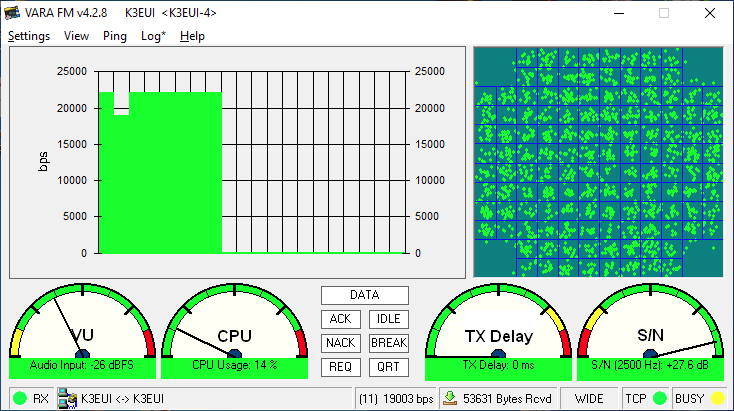Jeffs
I have used all three of the soundcards you mention (SignaLink, DRA SR, and the Digirig) and all of them worked fine driving three different radios on VARA FM “WIDE”.
The three radios I have are a 20 year old Kenwood DM700 with the 6 pin MINI DIN port and the MENU set to 9600 baud. Next radio is another 20 year old Icom 746Pro with the same 6 pin MINI DIN data port. Since this is also an HF SSB rig as well as 2m, the MODE on the 746Pro must be in FM-DATA mode, or USB-DATA mode to have access to the rear data port. And the third rig where I operate VARA FM WIDE is an Icom 2820 (10 yr old) with again the identical 6 pin MINI DIN port.
The differences with these three radios are minor from one (high quality) sound card to another, but the way the radio SEND (PTT) is accomplished is of more concern (to me).
SignaLinks are fantastic and easy to set up and to adjust with those TX, RX, and DLY knobs on the front. The SignaLink, however, is forced to use the TX sound itself (converted to a DC voltage) to trip a relay to assert PTT. Normally that works fine with slow constant output sounds (FT8, Olivia, MFSK) but on VARA (both HF SSB and VHF FM) the sounds go on and off in short bursts, so the VOX is rather sensitive to changes in volume of TX audio. It works, but is a bit finicky to establish the right level of audio to hold the VOX. And that third knob (DLY) controls the delay from TX back to RX on the radio - some call it the HANG TIME. It has to be set to a very low value to operate VARA (HF SSB or VHF FM).
The DRA sound cards use a clever feature of the C-Media sound chips that involving sending a signal to the sound chip itself to turn on a pin to a positive voltage - GPIO. The sound card can use this constant voltage out of one pin to once again, trip a relay to accomplish PTT (send). The DRA also has two channels (left/right) where the SignaLink is MONO (left only). Some DRAs have knobs and some have internal potentiometers (less convenient).
The Digirig uses the more conventional COM port through the usb cable. A (virtual) COM port is set up when you plug in the usb cable to the computer. It sets up a Silicon Labs COM port (with a number). Most applications (FLDIG, WSJT FT8, Winlink, VAR AC can accomplish PTT by using this COM port. The application sends a positive voltage on the RTS pin (on the serial port) which again, sends a signal to a relay or to a transistor switch inside the sound card to “ground the PTT” line on your radio’s DATA jack. It works beautifully and this PTT is NOT related to the value of the TX signal.
When you do an AUTO TUNE on VARA FM, the first few trials are often missed on a Signalink if you do not have sufficient TX audio to trip the VOX circuit. Not a big deal - but something to be aware of. The DRA and Digirig don’t use VOX.
So the answer to your question is …. they all work.
I’d add from my experience they all work well, both on HF SSB modes and on VHF/UHF FM modes.
The “older” Signalinks might not do VARA “WIDE” since this modulation needs about 6 kHz of audio bandwidth. But …. don’t get caught up in VARA “WIDE”.
It is at best only twice the speed of VARA “narrow” (3 kHz).
Unless you are a GATEWAY I would be content with a good S/N on VARA narrow and get up to 12000 bit/second data speeds.
Some folks want to do digital modes with cheap HTs.
I wrote up a short paper on this QST April 2022 on Baofeng.
Yes, you might get it to work (VARA narrow only) but I would not use an HT if deployed in any kind of EMCOMM situation other than to pick up the mic and confirm something.
de k3eui barry
West Chester PA
Net manager: Pa NBEMS net (Sundays 7:30 am on 3583 kHz (VFO)
